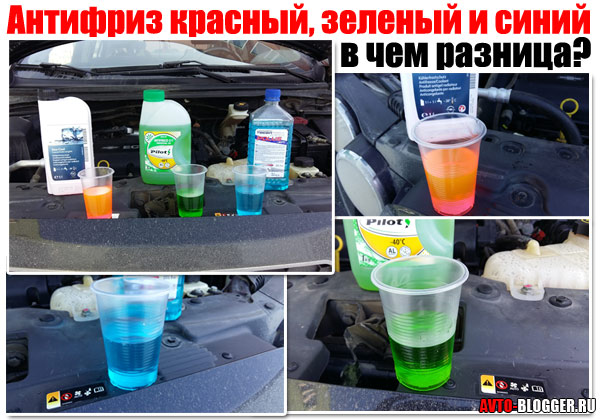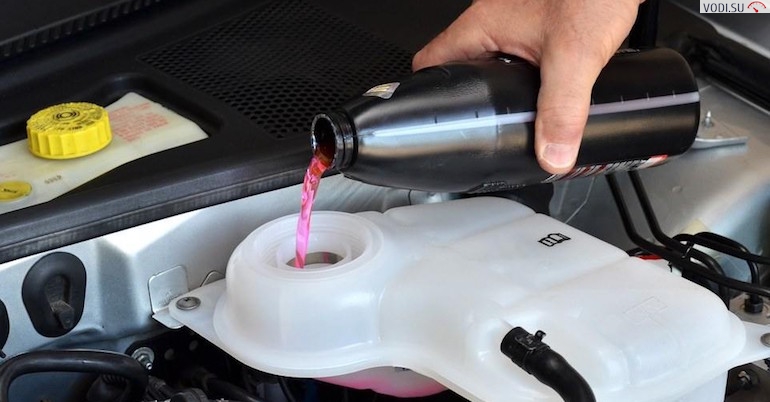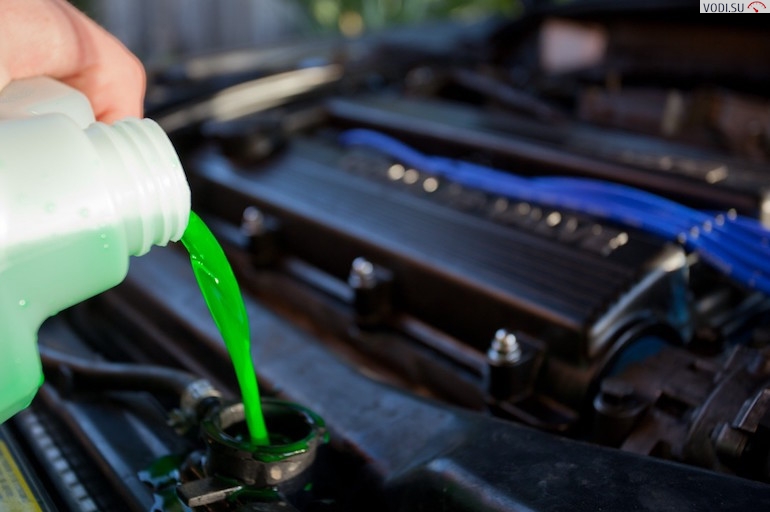
Antifreeze: red, green and blue
With the approach of the autumn-winter season, motorists are preparing cars for winter. One of the important tasks is the selection of antifreeze, thanks to which it is possible to protect the liquid in the cooling system from freezing.
There are myths among drivers about the differences between antifreeze and antifreeze, as well as antifreeze of various colors.
For example, many car owners are of the following opinion:
- Antifreeze is not antifreeze, it is the cheapest and therefore its service life is the shortest;
- red antifreeze liquid - the highest quality, it can not be changed for five years;
- The service life of green antifreeze is 2-3 years.
Let's try to deal with different types of antifreeze on the pages of our portal Vodi.su.

What is antifreeze?
First of all, you need to understand that any antifreeze is colorless. Color has absolutely no effect on any quality. They began to add dye in order to better see the leaks. Also, each manufacturer classifies its products in this way.
An antifreeze liquid is a solution of water with various substances that prevent it from freezing at temperatures below zero.
The most important parameter to pay attention to is the crystallization temperature. Or, to put it more simply, the freezing point. It can range from minus 20 to minus 80 degrees. Accordingly, if you dilute antifreeze, the crystallization temperature rises. Stick to the correct proportions when diluting, otherwise the liquid will freeze and costly repairs await you.
In Russia, a classification has been adopted, which is used in the Volkswagen concern:
- G12 and G12 + - contain corrosion inhibitors based on organic salts, form a protective layer in those parts of the engine where there is rust;
- G12 ++, G13 - they contain a mixture of organic and inorganic substances for corrosion protection, developed relatively recently;
- G11 - also contain both organic and inorganic salts.
There are also so-called traditional antifreezes, which use only inorganic salts. Antifreeze - a completely Soviet development - belongs to this group of non-freezing liquids. Today they are morally obsolete, since they protect much worse from corrosion. In addition, they need to be changed fairly regularly.

Antifreeze colors
What color to paint antifreeze in - such a decision is made directly by the developer of the liquid. So, Volkswagen uses the following classification:
- green, blue, sometimes orange - G11;
- G12 - yellow or red;
- G12+, G13 - red.
It should be noted that this scheme is rarely followed. Hence the rule - never be guided by color when choosing antifreeze or antifreeze. First of all, read the composition and look for the liquid tolerance class on the label. The same color is not a guarantee that the chemical composition of liquids from different manufacturers is the same. Carefully read the instructions for the car, and fill in the antifreeze recommended by the manufacturer.
If you have an American-made car, then the tolerance classes there absolutely do not coincide with European ones. The same applies to color. The fact is that America has its own standards and nitrite antifreezes are used there, which are considered carcinogenic, badly affecting the environment. However, you can often see the European analogue of the classification on the canister.
Japan also has its own system:
- red - minus 30-40;
- green - minus 25;
- yellow - minus 15-20 degrees.
That is, if you have a Japanese car, then you need to buy either an original Japanese-made fluid or one released under license, or look for a European equivalent. Usually it is G11 or G12.

Antifreeze replacement
The coolant must be changed regularly. We have already told on our Vodi.su portal how to do this, as well as how to flush the radiator. Even if you fill in expensive antifreeze, when you drain it, you will find that a lot of dirt settles in the engine.
If, for example, it happened that a radiator pipe burst on the road and antifreeze flows out, while the temperature in the yard is not below zero, then you can add plain distilled water to the radiator to get to the nearest car service.
It is necessary to regularly top up exactly the antifreeze that the manufacturer recommends. It is best to buy antifreeze from one company and leave it a little in reserve. In this case, you can not worry about topping up and mixing.
If you want to completely drain the coolant and fill in a new one, then you need to choose the right antifreeze according to the tolerance class. Color does not matter.
Well, if it turned out that you accidentally mixed various types of antifreeze, then you urgently need to drain the liquid and flush the entire system. Then you can pour the desired amount of antifreeze.
Remember that you can not focus on color. Each automaker produces engines with its own characteristics. Carboxyl, silicate or carbon additives can cause significant damage to it - precipitate and lead to early wear of the power unit and its elements.
Flush the cooling system only if the drained antifreeze contains a large amount of dirt and solid particles. Fill with new antifreeze following the vehicle manufacturer's instructions.
Loading…